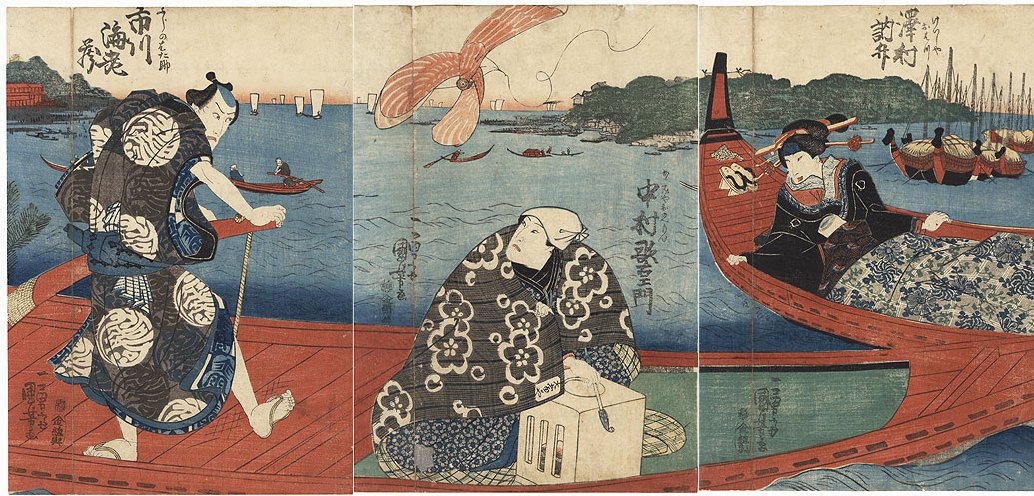| |
KUNIYOSHI(1797 - 1861)'Ferry, Passing a Beauty in a Boat'(descriptive title) |

'Ferry, Passing a Beauty in a Boat'
(descriptive title)
pre 1842
Comment - Triptych depicting a kabuki
scene of a ferry passing a beauty riding in a boat as a kite
with a broken string flutters loose through the sky above. The
kite is a classical tonbi-tako
(鳶凧) or bird-of-prey kite (hawk kite). The kite line must have been
broken only seconds ago, because the line left to the kite
still curls. None of the passengers seems to pay any attention
to the kite above. The warm clothing worn by the actors
suggests that the scene takes place during the cold season.
The Kabuki artist Sawamura Tossho (沢村訥升, aka Suketakaya Takasuke-III, 1802-1853) performs in an Onnagata role (女形, lit. "female role") in the right panel of this triptych as the geisha Ohatsu (お初). She is is bundled up in a leisure boat drifting towards he boat in the centre panel. The beauty smiles as she holds both coamings of the small boat, her legs tucked under a quilt and her geta clogs neatly placed on the deck behind her.
The Kabuki artist Sawamura Tossho (沢村訥升, aka Suketakaya Takasuke-III, 1802-1853) performs in an Onnagata role (女形, lit. "female role") in the right panel of this triptych as the geisha Ohatsu (お初). She is is bundled up in a leisure boat drifting towards he boat in the centre panel. The beauty smiles as she holds both coamings of the small boat, her legs tucked under a quilt and her geta clogs neatly placed on the deck behind her.
Ichikawa Ebizo-V (市川 海老蔵-五代目, aka Ichikawa Danjuro-VII, 1791-1859) performs as Iwafuji no Hatasuke (岩藤の畑助). He is the ferryman and handles the stern sculling oar at left, grimacing angrily at his passenger.
Nakamura Utaemon-IV (中村歌右衛門-四代目, aka Tamasuke, 1796-1852) plays Kagamiya Onoe (加々見山 尾上). She huddles around a caharcoal brazier with a quilt draped over her shoulders, and stares back with a frown as she looks up, a pipe in one hand and a white cloth wrapped around her head.
The plot of this drama named Kagamiyama
(Mirror Mountain, 加々見山), centers on a vendetta between rival
factions among the ladies-in-waiting in a samurai residence. Although
in the traditional version, Ohatsu is not a geisha but a
household servant, and Iwafuji is a female rival to Ohatsu's
mistress named Onoe. Known as Onna-Chushingura (female Chushingura) due to the
emphasis on the loyalty and fidelity of Ohatsu.
Kagamiyama themed plays were popular with women and typically staged in March in order to coincide with the month during which women serving in samurai mansions were usually permitted to go home to spend time with their families and would have been at liberty to attend a theatre.
Kagamiyama themed plays were popular with women and typically staged in March in order to coincide with the month during which women serving in samurai mansions were usually permitted to go home to spend time with their families and would have been at liberty to attend a theatre.
This triptych is a mitate, meaning that it is an imaginary scene with actors who never actually appeared together on stage in these roles.
Series - ~
Artist - see Biography
Signature - Ichiyûsai Kuniyoshi ga (一勇斎国芳画) on all three panels
Publisher - Sōshū-ya Yohei (総州屋与兵衛) below a circular single kiwame censor seal (極印) in use from 1791 ~ 1842, both on all three panels
Image Size - 35.2 x 74.9 cm (13 7/8" x 29 1/2")
Condition - trypich, three single panels; nishiki-e (cloured woodblock); Vertical ôban (ôban tate-e);
Copyright 2008 ff: Hans P. Boehme